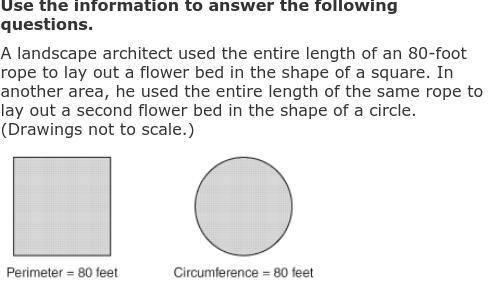
Mathematics, 14.05.2021 16:50 kenz2797
Use the information to answer the following questions.
A landscape architect used the entire length of an 80-foot rope to lay out a flower bed in the shape of a square. In another area, he used the entire length of the same rope to lay out a second flower bed in the shape of a circle. (Drawings not to scale.)
Activity 1 of 2
Part A: What is the area of the square?
A.
6,400 ft2
B.
320 ft2
C.
400 ft2
D.
4,000 ft2
Activity 2 of 2
Part B: What is the area of the circle rounded to the nearest square foot?
A.
509 ft2
B.
1,600 ft2
C.
251 ft2
D.
2,037 ft2


Answers: 2


Another question on Mathematics

Mathematics, 21.06.2019 15:00
Which property is illustrated by the following statement? if hxa rgi, then rgi hxa.
Answers: 1

Mathematics, 21.06.2019 19:30
Ann and betty together have $60 ann has $9 more than twice betty’s amount how much money dose each have
Answers: 1

Mathematics, 22.06.2019 00:00
I've been working on this for a few days and i just don't understand, it's due in a few hours. you.the direction of a vector is defined as the angle of the vector in relation to a horizontal line. as a standard, this angle is measured counterclockwise from the positive x-axis. the direction or angle of v in the diagram is α.part a: how can you use trigonometric ratios to calculate the direction α of a general vector v = < x, y> similar to the diagram? part bsuppose that vector v lies in quadrant ii, quadrant iii, or quadrant iv. how can you use trigonometric ratios to calculate the direction (i.e., angle) of the vector in each of these quadrants with respect to the positive x-axis? the angle between the vector and the positive x-axis will be greater than 90 degrees in each case.part cnow try a numerical problem. what is the direction of the vector w = < -1, 6 > ?
Answers: 1

Mathematics, 22.06.2019 03:20
Indicate the equation of the given line in standard form. the line containing the longer diagonal of a quadrilateral whose vertices are a (2, 2), b(-2, -2), c(1, -1), and d(6, 4).
Answers: 2
You know the right answer?
Use the information to answer the following questions.
A landscape architect used the entire length...
Questions




Mathematics, 26.09.2019 17:10





English, 26.09.2019 17:10

Mathematics, 26.09.2019 17:10






Computers and Technology, 26.09.2019 17:20






